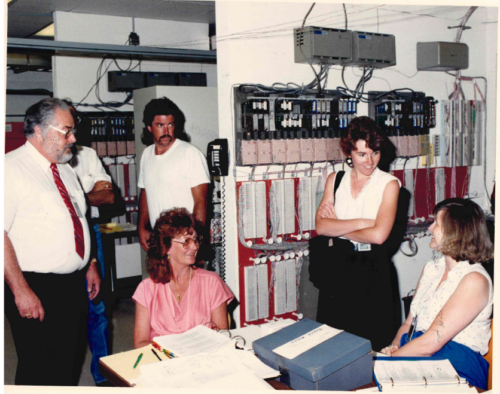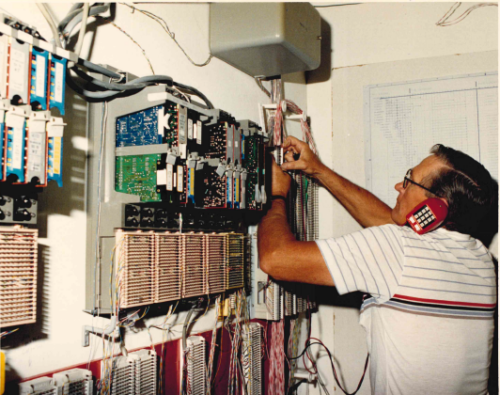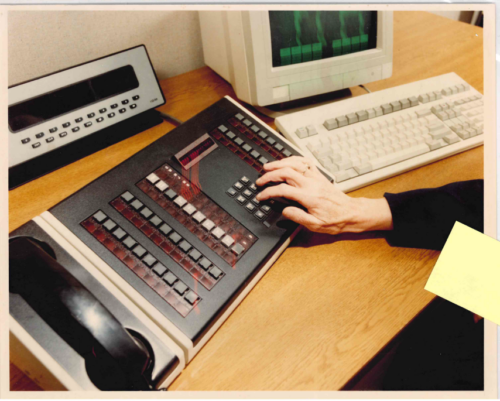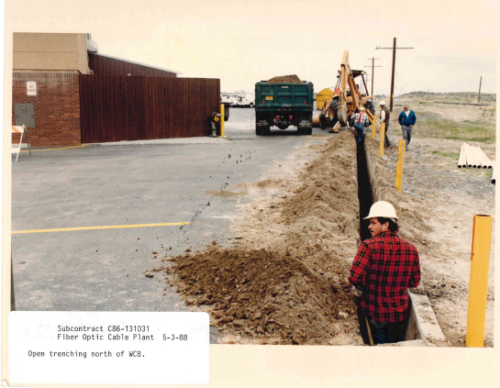Telecommunications in eastern Idaho today are vastly different from how they were in 1949, the year the Atomic Energy Commission (AEC) founded the National Reactor Testing Station, now Idaho National Laboratory. The days of copper wire, switchboard exchanges and phone numbers beginning with names (JAckson for Idaho Falls, SUnset for Blackfoot, SHerwood for Rigby) have long since given way to Voice over Internet Protocol, 5G and Zoom.
Back then, phone service already existed at the offices, homes, and workspaces at the Arco Naval Proving Grounds, now INL’s Central Facilities Area (CFA). Along with the railroad line to the proving grounds, workers strung copper telephone wire. In fact, phone service may have been one factor that made the Idaho site appealing to the AEC, which would build 52 reactors between 1949 and 1973.

A group of employees gathered around one of the old telecommunications systems.
Mountain Bell scrambles
The AEC decision to locate its reactor testing station headquarters in Idaho Falls put new pressure on the Mountain States Telephone and Telegraph Co. (Mountain Bell), which was already playing catch-up after World War II. Between 1950 and 1960, Idaho Falls’ population grew from 19,218 to 33,161, an increase of 72.5%. This growth prompted significant infrastructure upgrades, which included a large central office expansion in 1953, another building addition in 1956, and conversion to dial phones that December. Direct distance dialing followed in 1962, the same year Interstate 15 reached Idaho Falls.
High-tech error detection and correction teletype service came to the AEC’s Idaho operations office in 1963. (Teletype Corp. was the Bell System subsidiary responsible for data and record communications equipment.) Five years later, the first 24-hour data network was installed for the AEC, flashing 40,800 bits per second.
‘It was one continual upgrade’
Loren Webb, a Korean War veteran who started working at the testing station in 1955 as a laborer, witnessed the evolution of telecommunications at the Site firsthand. By October of his first year, he was involved in electronic communications at CFA and eventually became chief of the Site’s telecommunications operations, a position he held until his retirement in 1986.
In a 2019 interview, Webb, who died in 2023 at age 93, said most days involved laying wires and cables to facilities at all corners of the 890-square-mile Site. His last job, in the mid-1980s, involved upgrading the site to fiber-optic cable. “It was one continual upgrade,” he said.

An employee working with an old telecommunications system.
By far the most momentous day of Webb’s career was when President Lyndon Johnson visited in August 1966 to designate Experimental Breeder Reactor-I a National Historic Landmark. In addition to visiting the reactor, Johnson and his entourage traveled by helicopter to CFA, where the party ate lunch. At all times, for national security reasons, the president had to have telecom service within 50 feet of him, and the White House had asked for communications equipment to be put on the East Twin Butte. Dragging spools of cable up the mountain, one team member stepped on a rattlesnake. Although his boot protected him from the snake’s bite, he was startled enough to drop his spool and watch it roll down the hill.
Not only was LBJ’s visit the most challenging day of Webb’s career, it was also the most expensive. The $150,000 cost exhausted his budget for the year, he said. He received two letters of appreciation, one from the White House and one from W.L. Ginkel, head of the AEC’s Idaho Operations Office.
At that point, the Site’s telecommunications involved switchboards at CFA and in Idaho Falls, staffed by 18 operators. Webb oversaw payroll and negotiated contracts with Mountain Bell. When his operators went on strike for 90 days, in solidarity with other union workers at the Site, Webb and members of his staff operated the switchboards.
Electronic switching equipment finally came to Idaho Falls in 1975. Operator service ceased entirely in December 1981, when computerized equipment made consolidation and remote control possible from Pocatello, Boise and Salt Lake City.
AT&T breakup brings change
A new era began with the consent decree breaking up the Bell System, which went into effect on Jan. 1, 1984. In response to a Justice Department suit, American Telephone & Telegraph — “Ma Bell” — agreed to break itself up into seven autonomous regional holding companies. These “Baby Bells” included U.S. West, which absorbed Mountain Bell and covered 14 states including Idaho.

An old telephone system.
One of the Justice Department’s major demands was for AT&T to relinquish Western Electric, the company that produced most of its equipment. Although the internet was still a dot on the horizon, technological innovation and competition exploded in the 1980s.
“Once they broke up the Bell System, all these other companies came up,” said Paul Martinez, supervisor of INL’s Vulnerability Management operations. “IT wouldn’t exist if it was still Mountain Bell,” he said.
Though workers laid INL’s first fiber optic cable in the mid-1980s, U.S. West did not upgrade its voice switching. In 1989 INL subcontractors brought in new digital switching, eliminating the need for U.S. West stepper switch services, said Michael Cannon, customer engagement manager for INL’s Information Technology office. “At the beginning, we were patching things to make services work,” Cannon said.
Tech takes off
The growth and innovation in INL Information Technology (IT) over the last 35 years has been both dramatic and dizzying.
In the early 1990s the entire Site was running on one T1 line, transmitting data at 1.544 Mbps. A T1 line can transmit data into 24 channels, which means 23 channels can support 23 simultaneous voice calls while the 24th is reserved for signaling information. Even today, for cost reasons small businesses still choose T1 service for high-speed data transmission, internet access and voice.

Open trenching to lay fiber optic cables near INL’s Willow Creek Building.
In 2006, with bandwidth requirements growing, INL added switches to the network to increase the overall speed to 2.5 gigabits. This paved the way for full Internet access to all streaming data, allowing for many Internet connections at a time.
Looking back, to 1984 or to 1949, few people could have imagined what INL’s telecommunications and supercomputing capacities would grow into, and how they would affect every aspect of the lab’s mission. The work is still one continual upgrade.
With the advent of supercomputers in the late 1990s, the Site now has a 100-gigabit connection to the outside world. “Nothing much happens without IT infrastructure,” Martinez said. “By 2006, we were able to run gig circuits all over the place. That was a huge breakthrough for us and INL.”
See this article on the INL's website.
About Idaho National Laboratory
Battelle Energy Alliance manages INL for the U.S. Department of Energy’s Office of Nuclear Energy. INL is the nation’s center for nuclear energy research and development, celebrating 75 years of scientific innovations in 2024. The laboratory performs research in each of DOE’s strategic goal areas: energy, national security, science and the environment.
Follow the INL on social media: Facebook, Instagram, LinkedIn and X.
